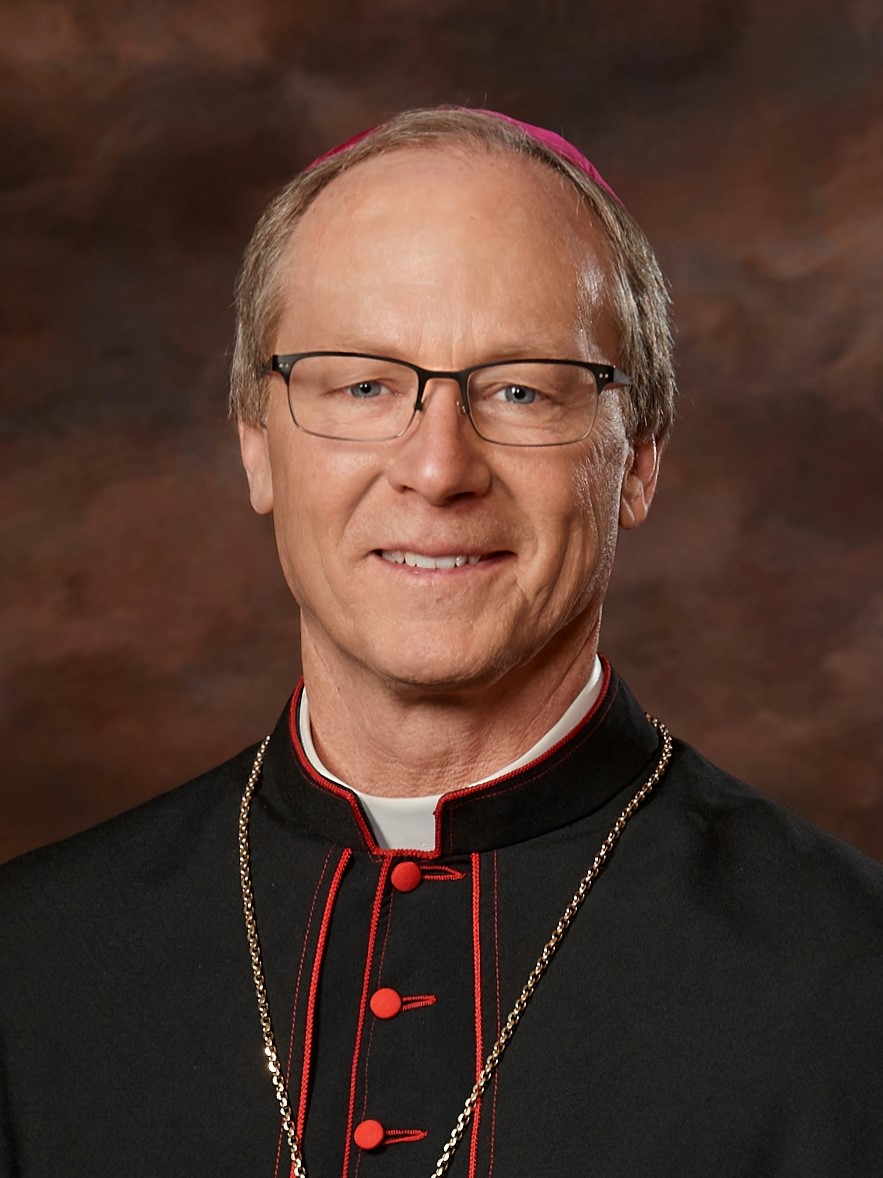

Most Reverend Jeffrey Joseph Walsh (born November 29, 1965) is an American prelate of the Roman Catholic Church who currently serves as the sixth bishop of the Diocese of Gaylord in Michigan.
Pope Francis appointed Walsh as bishop of the Diocese of Gaylord on December 21, 2021. Walsh’s episcopal ordination and installation as bishop took place on March 4, 2022, at St. Mary Cathedral in Gaylord, Michigan.
Early Life
Jeffrey Walsh was born in Scranton, Pennsylvania on November 29, 1965. The son of Jerome and Nancy Walsh, he is a native of Scranton, Pa., and is a graduate of Scranton Central High School. He is one of three children, with brothers James and Joseph Walsh. He graduated from the University of Scranton in 1987 with a bachelor’s degree in health and human resources.
He went on to complete his priestly studies at Mount St. Mary’s Seminary, Emmitsburg, Maryland, earning a Master of Divinity Degree. Walsh received a Master of Arts in Christian Spirituality from Creighton University in 1999 and a Master of Social Work Degree from Marywood University in 2010.
Priesthood
Walsh was ordained a priest of the Diocese of Scranton by Bishop James C. Timlin at the Cathedral of Saint Peter, Scranton, Pennsylvania on June 25, 1994. After ordination, he served as assistant pastor at Saint Rose of Lima Church, Carbondale, and the Cathedral of Saint Peter, Scranton. In July 1999, he was appointed to his first pastorate at Saint Mary of the Lake Church, Lake Winola, as well as Director of Spiritual & Liturgical Formation at Saint Pius X Seminary in Dalton, Pennsylvania. From July 2004-July 2006, he served as pastor at Nativity of the Blessed Virgin Mary Church, Tunkhannock, until being appointed to serve as Episcopal Vicar for the Eastern Pastoral Region of the Diocese of Scranton.
In 2008, Walsh became administrator of Saint Rita Church, Gouldsboro, and in 2009 was appointed administrator of Saint Anthony, Saint Bridget and Saint John the Baptist parishes in Throop. In July 2010, he was appointed to serve as pastor at the Church of Saint John, East Stroudsburg.
In January 2015, he was appointed Episcopal Vicar for Clergy by Bishop Joseph C. Bambera. While serving in that role Walsh also served as Sacramental Minister for Our Lady of the Eucharist Parish, Pittston. In July 2020, he was appointed pastor at Saint Rose of Lima Parish, Carbondale, and Our Lady of Mount Carmel Parish, Carbondale.
During his years of pastoral ministry, Walsh also served in a variety of diocesan positions, including Director of Religious Formation at the former Sacred Heart High School in Carbondale and the former Bishop Hannan High School in Scranton. For five years, he was Chaplain at Saint Michael’s School and for 12 years (1995-2007) he served as Chaplain to the Deaf Community. Walsh has also served as Diocesan Vocations Director, was director of youth and young adult retreats at Fatima Center and served for one year as the Diocesan Deputy Secretary for Catholic Human Services. In 2007, he was also appointed to the Board of Directors of the Notre Dame Regional School System.
Bishop of Gaylord
On December 21, 2021, Pope Francis announced that Walsh had been appointed to serve as sixth bishop of the Diocese of Gaylord. The diocese includes 75 parishes, two shrines, one chapel and 16 Catholic schools. It is comprised of 11,171 square miles in the State of Michigan and has a total population exceeding 506,000 of which approximately 44,000 are Catholic.
Traveling across Gaylord’s expansive diocese, Bishop Walsh regularly visits parishes and schools to proclaim the Gospel, teach the faith and celebrate the sacraments in unity with clergy and lay leaders. He also actively services on the Catholic Human Services Board of Directors, the Northern Michigan Catholic Foundation Board, the Michigan Catholic Conference Audit Committee, the USCCB Catholic Home Mission Subcommittee and the USCCB Native American Affairs.
Pope Francis Names Father Jeffrey Walsh of Diocese of Scranton as Bishop of Gaylord
Scranton native named bishop in Michigan
Times Tribute
Bishop Walsh’s episcopal ordination and installation as the sixth bishop of Gaylord took place on March 4, 2022 at Saint Mary, Our Lady of Mount Carmel Cathedral in Gaylord.
 Heraldic Achievement of the Most Reverend Jeffrey J. Walsh
Heraldic Achievement of the Most Reverend Jeffrey J. Walsh
Azure, within a bordure wavy a chevronel between in chief two mullets of six points argent and in base a Latin Cross pattee Or, impaling Per chevron azure and sable, a chevron flory counter-flory and a chevron the upper line sapiné, the lower line wavy argent, between a chief rayonny Or, and in base a pheon argent.
Designing his shield—the central element in what is formally called the heraldic achievement—a bishop has an opportunity to depict symbolically aspects of his life and heritage, and elements of the Catholic faith that are important to him. Every coat of arms also includes external elements that identify the rank of the bearer. The formal description of a coat of arms, known as the blazon, uses a technical jargon, derived from French and English terms, that allows the appearance and position of each element to be recorded precisely.
A diocesan bishop shows his commitment to the flock he shepherds by combining his personal coat of arms with that of the diocese, in a technique known as impaling. The shield is divided in half along the pale or central vertical line. The arms of the diocese appear on the dexter side—that is, on the side of the shield to the viewer’s left, which would cover the right side (in Latin, dextera) of the person carrying the shield. The arms of the bishop are on the sinister side—the bearer’s left, the viewer’s right.
The arms of the Diocese of Gaylord have a field of blue (azure) surrounded by a white border drawn with wavy lines. This alludes to the position of the diocese at the northern end of Michigan’s Lower Peninsula, where it is situated amid the waters of Lake Huron, Lake Michigan, and the Straits of Mackinac. The geography of the diocese is also symbolized by the chevronel, the thin V-shaped design painted white (argent), which alludes to a mountain peak, recalling that the City of Gaylord is at the highest elevation in the Lower Peninsula.
The gold Cross represents the planting of the Faith in the region. Taken together with the chevronel, which can also recall the trusses of a peaked roof, it brings to mind the parish churches where the people of the diocese gather to worship God.
In the upper part of the shield are two six-pointed stars (mullets), which are drawn from the coat of arms of the Carmelite Order; the Blessed Virgin Mary is the patroness of the diocese under her title of Our Lady of Mount Carmel. They also allude to the two Michigan dioceses—Grand Rapids and Saginaw—from whose territory the Diocese of Gaylord was formed in 1971.
The design of Bishop Walsh’s arms is meant to illustrate the motto that appears on the scroll below the shield, “Divine Providence.” Read from the bottom up, it traces the plan and providence of God as it has unfolded in the life of the Bishop.
In the lower part of the shield (in base) appears an arrowhead, known in heraldry as a pheon. The family arms of the Walsh sept or clan in Ireland display three pheons painted black (sable) on a white shield, with a red chevron between the two at the top of the shield (in chief) and one in base. A pheon appears here to recall those arms, but with the colors reversed. The black pointed background on which the pheon appears recalls the Bishop’s birth and upbringing in Northeastern Pennsylvania. Large deposits of anthracite coal have been mined for more than a century in the region, and the “coal country” became home to many Catholic immigrants from Ireland and various parts of central and eastern Europe.
At this point the viewer encounters the first of two white chevrons. This one is drawn with wavy lines on its lower edge, while the upper edge is drawn to resemble evergreen trees (sapiné). This recalls the geography of the Diocese of Scranton, which Bishop Walsh served as a priest for more than 27 years, as well as the Diocese of Gaylord. The territories of both dioceses comprise many evergreen forests and numerous lakes, rivers and streams.
Another white chevron is drawn flory counter-flory, that is, with heraldic lilies (fleurs-de-lis) around its edges placed in alternating directions. This chevron symbolizes the Bishop’s devotion to the Holy Family of Jesus, Mary and Joseph. Lilies, and particularly the fleur-de- lis, are a symbol of purity and chastity that have long been associated with the Blessed Virgin Mary, and with Saint Joseph as well. The chevron also resembles a carpenter’s square, another attribute of Saint Joseph, and of Jesus, known in his hometown of Nazareth as “the carpenter’s son” (Mt 13:55).
Finally, rays painted gold are seen descending from the top of the shield (a chief rayonny Or). This is meant to symbolize the Divine Providence of Almighty God, who bestows grace, wisdom and strength to enable each person to understand and embrace His Will in every moment. The various chevrons can be seen as pointing in the direction of God, who leads the individual step by step through his life and vocation, always tending toward the fulfilment of life in Heaven.
The shield is ensigned with external elements that identify the bearer as a bishop. A gold processional cross appears behind the shield. The galero or “pilgrim’s hat” is used heraldically in various colors and with specific numbers of tassels to indicate the rank of a bearer of a coat of arms. A bishop uses a green galero with three rows of green tassels.
Leave a message of welcome for Bishop Walsh:
Email or mail to:
Diocese of Gaylord
ATTN: Office of Communications
611 W North Street
Gaylord, MI 49735
- Formal Portraits of the Most Reverend Jeffrey J. Walsh
- Novena Prayer for the Most Reverend Jeffrey J. Walsh
Novena prayer for the Most Reverend Jeffrey J. Walsh. This novena was prayed on the days leading up to Bishop Walsh's episcopal ordination and installation but it is encouraged that the faithful of the Diocese of Gaylord continue to use it as a way of keeping our shepherd in our prayers.
- Video of the Ordination & Installation of the Most Reverend Jeffrey J. Walsh | March 4, 2022
- Video of Solemn Vespers on the Eve of the Ordination & Installation of the Most Reverend Jeffrey J. Walsh | March 3, 2022
- Video of the press conference announcing Jeffrey J. Walsh as the sixth bishop of Gaylord | December 21, 2021
Initial press release announcing Jeffrey J. Walsh as the sixth bishop of Gaylord






